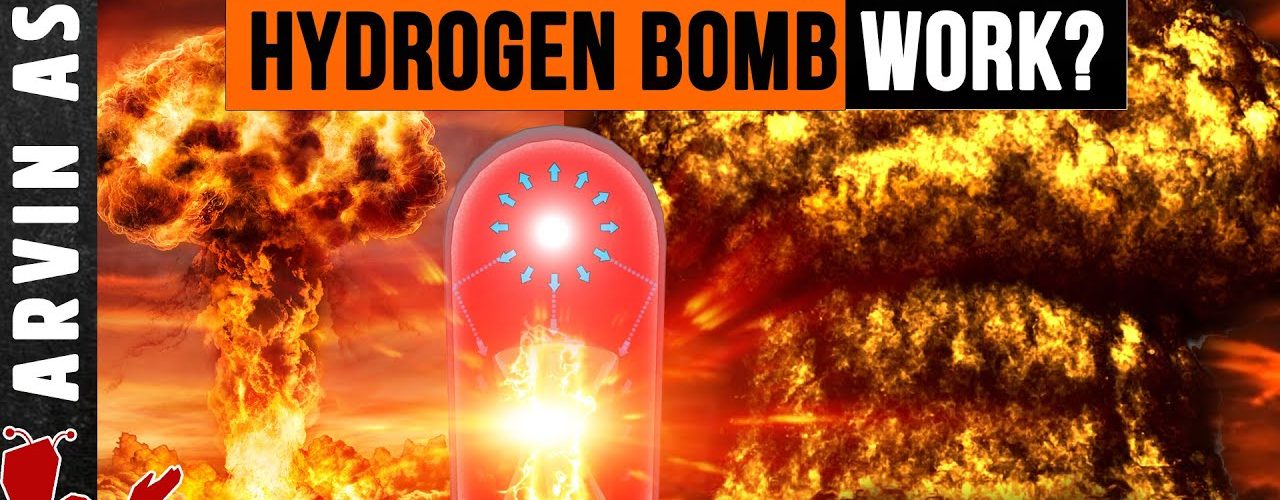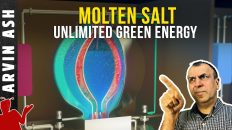How does a hydrogen bomb work? Mankind had never seen anything like it. When it was unleashed on people in an effort to stop a war, all people saw was a blinding light, followed by complete darkness and destruction.
It was August 6th 1945. It was the most powerful weapon ever created by mankind. It’s shock wave turned everything in a 1 mile radius to rubble.
It unleashed energy and radiation that killed 140,000 people in the industrial city of Hiroshima Japan.
As powerful as this bomb was, mankind has since invented a weapon that Is hundreds of times more powerful.
Today, we have thermonuclear weapons, also called the hydrogen bomb. To give you an idea of its power, if the original Hiroshima bomb was dropped in New York City, heaven forbid, it would destroy everything in a 1 mile radius.
If a hydrogen bomb was dropped there, heaven forbid, it would not just destroy everything in a one mile radius, It would make into rubble everything in an 8 mile in radius. This would be a total calamity.
The world now has over 10,000 such bombs, capable of easily destroying every single person on our planet, many times over.
What makes these weapons so powerful? How do they actually work?
The bomb on Hiroshima released the energy equivalent of 15,000 tons of TNT. The first hydrogen bomb released the energy equivalent of 10,000,000 tons of TNT.
While the atomic bomb like the one that was dropped on Hirsoshima worked on the principle of releasing energy through the splitting of atoms – also called fission, See my video on that. — a hydrogen bomb does something that releases even more energy, and that is it fuses atoms together.
Fusion is even more powerful than fission. It is the same process that powers our sun.
And when fission is combined with fusion in a hydrogen bomb, it creates energy orders of magnitude higher than fission alone, making hydrogen bombs 100’s to 1000’s of times more powerful than atomic bombs.
How does fusion work?
The fusion portion of the bomb creates energy by combining two isotopes of hydrogen called deuterium and Tritium to create helium.
Unlike a natural hydrogen atom that is made of one electron orbiting around a proton, these isotopes have extra neutrons in their nuclei.
A large amount of energy is released when these two isotopes fuse together to form helium because a helium atom has much less energy than these two isotopes combined. This excess energy is released.
One of the main problems with creating the Hydrogen bomb was obtaining the tritium. Scientists found that they could generate this on-the-spot inside the hydrogen bomb with a compound combining lithium and deuterium. The result was a dry, solid, stable powder called Lithium-deuteride. So this is what most hydrogen bombs today use as their fuel today.
But how does the process of fusion actually occur?
Ordinarily the nuclei of two atoms cannot be combined because these nuclei have strong positive electrical charges and repel each other.
This is why scientists chose hydrogen as the best candidate for fusion because it has only one proton, and thus would have less electrical charge than atoms with multiple protons in their nuclei.
But if the nuclei repel each other, how do they fuse? It turns out that if you increase the temperature by millions of degrees, it is possible to combine nuclei together.
As the temperature increases, the atoms speed up. But an extraordinary increase in speed of the atoms is needed in order to give them a chance to overcome their natural repulsion.
The temperatures needed are astronomical – higher than even that at the center of the sun – 100 million degrees celcius. (Center of sun is 15 million degrees) At this temperature, the isotopes become a form of matter called plasma.
This is when the electrons orbiting the nuclei is stripped away from the nucleus and the nuclei and electrons are floating around freely in a kind of high temperature soup.
At this temperature, the nuclei can get very close to each other – and when they get as close as 1X10^-15 meters apart, then the strong nuclear strong force which is present only at very close distances and is responsible for keeping protons and neutrons glued together, takes over and binds the protons and neutrons together to form a helium nucleus and a free neutron.
So how is a temperature of 100 million degrees achieved?
This is where the fission or atomic bomb inside the hydrogen bomb enclosure comes in.
The purpose of the fission bomb is to provide the energy needed to heat up the fusion reaction to this 100 million of degrees.
So how do they work together?
A hydrogen bomb is actually three bombs in one. It contains an ordinary chemical bomb, a fission bomb like the one dropped on Nagasaki, and a fusion bomb.
All three work in concert. The chemical bomb initiates the fission bomb which initiates the fusion bomb.
To understand how the fission and fusion bombs work together, it is important to understand how the bomb is put together.
In a ballistic missile, the bomb is usually located at the top, inside the cone portion of the missile. Here is where the hydrogen bomb vessel sits.
The casing of the bomb is lined with beryllium, this acts as a mirror to reflect the neutrons back into the casing rather than allowing them to escape the vessel.
A small atomic bomb is located at the top of the casing. It is shaped like a sphere. The top of the sphere contains conventional chemical explosives surrounding a sphere of beryllium mirror casing, inside of which is a smaller uranium or plutonium sphere about 4 to 6 inches in diameter.
Below this atomic bomb is the hydrogen or fusion bomb. It consists of a cylinder made of uranium, the fuel for the fusion reaction, lithium deuteride sits inside the cylinder. And at the core of this cylinder sits a rod of plutonium.
In between the fission and fusion bomb is an encasing made of Styrofoam.
And here is how all this works together.
Here is what happens. First, the fission bomb is detonated by exploding conventional chemical bombs in sequence, this forces the sphere of plutonium 239 or Uranium 235 to implode on itself.
The implosion or compression of this material creates a critical mass which results in a chain reaction of neutrons splitting atoms apart, and creating more neutrons which split more atoms apart. The chain reaction results in an atomic bomb explosion.
This fission explosion creates high energy gamma rays and X-rays which heat up the Styrofoam and turns it into plasma. This plasma reflects off the baryillium lined walls and focuses its energy on the fusion cylinder.
These x-rays travel at the speed of light, so they reach the hydrogen fuel sooner than the physical shock wave from atomic bomb. This is important because if the shock wave reached there first, then the fusion bomb would be blown apart before it could create fusion reactions.
The heat and pressure of the plasma compresses the fusion cylinder causing the lithium-deuteride to react. This releases tritium.
The Tritium and deuterium fuse to form Helium and more neutrons. The neutrons cause the uranium casing and plutonium rod to undergo more fission reactions. This causes more pressure on the lithium-deuteride not only from the outside in, but also from the inside out. This produces more fusion, and releases more neutrons which cause more fission.
This positive feedback loop of fission-fusion-fission-fusion reactions goes back and forth until a huge explosion occurs ripping everything apart.
All of these events happen in about 600 billionths of a second (550 billionths of a second for the fission bomb implosion, 50 billionths of a second for the fusion bomb). The result is an immense explosion with a 10,000,000 ton yield — 700 times more powerful than the Hiroshima.
And where does all this energy actually come from? Well if you could weigh all the atoms of the fuel before the explosion and all the atoms released after the fusion. The sum of all atoms after the explosion would be less than the sum of all the atoms before the explosion.
This mass is converted to energy using Einstein’s famous equation E=MC^2.
And exactly how much mass is converted to energy. To give you an idea, the bomb dropped on Hiroshima converted 700 miligrams of mass into energy, about one third the mass of a US penny. The total uranium used was 55 lbs. A hydrogen bomb however converts about a kilogram or 2 lbs of mass to pure energy. But in order to convert this much, you have to start with about 140 kilos or 300 lbs. of hydrogen.
Only six countries have such bombs —China, France, India, Russia, United Kingdom, and the United States, — and all have conducted hydrogen bomb tests.
Almost all of the nuclear weapons deployed today are hydrogen bombs because they are much smaller and lighter, and so can be deployed in intercontinental ballistic missiles. These things don’t just kill, they annihilate. We humans have become quite efficient at it.







